Sudetendeutsches Freikorps
Sudetendeutsches Freikorps (Sudeten German Free Corps, also known as the Freikorps Sudetenland, Freikorps Henlein and Sudetendeutsche Legion) was a paramilitary Nazi organization founded on 17 September 1938 in Germany on direct order of Adolf Hitler. The organization was composed mainly of ethnic German citizens of Czechoslovakia with pro-Nazi sympathies who were sheltered, trained and equipped by the German army and who were conducting cross border terrorist operations into Czechoslovak territory from 1938 to 1939. They played an important role in Hitler's successful effort to occupy Czechoslovakia and annex the region known as Sudetenland into the Third Reich under Nazi Germany.[1][2][3][4]
| Sudeten German Free Corps | |
|---|---|
| German: Sudetendeutsches Freikorps | |
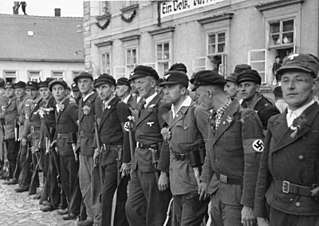 Sudetendeutsches Freikorps members | |
| Active | 1938 to 1939 |
| Country | |
| Allegiance | Adolf Hitler |
| Type | Terrorist organization |
| Role | Break-up of Czechoslovakia |
| Engagements | Undeclared German-Czechoslovak war |
| Commanders | |
| De facto commander | |
| Formal commander | |
| Vice-commander | |
| Chief of staff | |
Sudetendeutsches Freikorps was a factual successor to Freiwilliger Schutzdienst, also known as Ordnersgruppe, an organization that had been established by the Sudeten German Party in Czechoslovakia unofficially in 1933 and officially on 17 May 1938, following the example of Sturmabteilung, the original paramilitary wing of the German Nazi Party. Officially being registered as promoter organization, the Freiwilliger Schutzdienst was dissolved on 16 September 1938 by the Czechoslovak authorities due to its implication in many criminal and terrorist activities. Many of its members as well as leadership, wanted for arrest by Czechoslovak authorities, had moved to Germany where they became the basis of Sudetendeutsches Freikorps, conducting Freikorps' first cross-border raids into Czechoslovakia only a few hours after its official establishment.[5] Due to the smooth transition between the two organizations, similar membership, Nazi Germany's sponsorship and application of the same tactic of cross-border raids, some authors often do not particularly distinguish between the actions of Ordners (i.e. up to 16 September 1938) and Freikorps (i.e. from 17 September 1938).
Relying on the Convention for the Definition of Aggression, Czechoslovak president Edvard Beneš[6] and the government-in-exile[7] later regarded 17 September 1938, the day of establishment of the Sudetendeutsches Freikorps and beginning of its cross-border raids, as the beginning of the undeclared German–Czechoslovak war. This understanding has been assumed also by the contemporary Czech Constitutional court.[8] Meanwhile, Nazi Germany formally declared that Czech captives shall be considered prisoners of war from 23 September onwards.[9]
Background
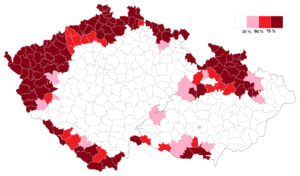
From 1918 to 1938, after the breakup of the Austro-Hungarian Empire, more than 3 million ethnic Germans were living in the Czech part of the newly created state of Czechoslovakia.
In 1933, as Adolf Hitler assumed power in Germany, Sudeten German pro-Nazi leader Konrad Henlein founded Sudeten German Party (SdP) that served as the branch of the Nazi Party for the Sudetenland.[11] By 1935, the SdP was the second largest political party in Czechoslovakia.[11] Shortly after the anschluss of Austria to Germany, Henlein met with Hitler in Berlin on 28 March 1938, where he was instructed to raise demands unacceptable to the Czechoslovak government led by president Edvard Beneš. On 24 April, the SdP issued a series of demands upon the government of Czechoslovakia, that were known as the Carlsbad Program. [12] Among the demands, Henlein demanded autonomy for Germans living in Czechoslovakia.[11] The Czechoslovakian government responded by saying that it was willing to provide more minority rights to the German minority but it refused to grant them autonomy.[11]
By June 1938, the party had over 1.3 million members, i.e. 40.6% of ethnic-German citizens of Czechoslovakia (40% of that women). During last free democratic elections before the German occupation of Czechoslovakia, the May 1938 communal elections, the party gained 88% of ethnic-German votes, taking over control of most municipal authorities in the Czech borderland. The country's mass membership made it one of the largest fascist parties in Europe at the time.[13]
The first major crisis took place in May 1938 after a partial Czechoslovak army mobilization. Activities of pro-Nazi ethnic Germans in the area led to a large flight of ethnic-Czech civilians and especially Jews. Hitler's increasing threats of attacking Czechoslovakia led to full mobilization on 22 September 1938. Many ethnic-Germans refused to follow the Czechoslovak army mobilization order and either ran across the border to Germany and joined Freikorps, continuing cross border raids from there, or established Grün Freikorps units which were operating from Czechoslovak forests, receiving arms and equipment from Germany, and continuing raids against Czechoslovak authorities, Jews and Czechs, up until the German occupation of the Czechoslovak border areas following the Munich agreement.
Ordnersgruppe, Freiwilliger Schutzdienst
| Freiwilliger Schutzdienst | |
|---|---|
| German: Ordnersgruppe | |
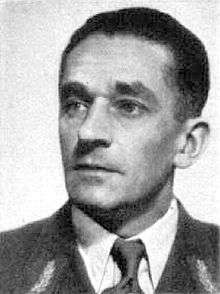 Karl Hermann Frank, FS's vice-Führer who was receiving orders directly from Hitler | |
| Active | 17 May 1938 to 16 September 1938 |
| Country | |
| Allegiance | |
| Type | Terrorist organization |
| Role | Break-up of Czechoslovakia |
| Commanders | |
| Führer | |
| Vice-Führer | |
| Secretary | |
| Chief of staff | |
Forming of the organization
Immediately after establishing the Sudetendeutsche Heimatfront (later Sudeten German Party, SdP) in 1933, the party started forming its informal Ordnungsdienst (Order Service, its members called in German Ordners) which was officially supposed to preserve order during meetings and assemblies of the party and protect it against its political adversaries. In reality, however, these were from the beginning attack squads with potentially terrorist assignments,[14] following the example of Sturmabteilung (a.k.a. "Brown shirts" or "Storm Troopers"), the original paramilitary wing of the German Nazi Party.[5] More systematic build-up of the paramilitary wing started before the 1935 elections, when the SdP's leadership decided that each local SdP organization should establish its own squad of Ordners.[15]
On 14 May 1938, the Ordnersgruppe was formally transformed into new official organization called the Freiwilliger Schutzdienst (FS) which was openly built up following the example of the Nazi Sturmabteilung.[16] SdP's chief Konrad Henlein was the Schutzdienst's Führer, with Fritz Köllner becoming its secretary and Willi Brandner the chief of staff, also responsible for the buildup of squad groups. By 17 May 1938, the date of the organization's official registration, Schutzdienst had over 15.000 members.[16]
Schutzdienst started a wide recruitment program in June 1938. Its members were divided into three categories:[16]
- Category A: The most trusted and physically capable members that were supposed to carry out the duty of guardians of "inner purity" of the SdP. The Category A was composed of the so-called "surveillance departments" and was directly subordinate to the SdP. Apart from functions within the organization, its members were also collecting information on political opponents and conducting military espionage.[16]
- Category B: Wider selection of members. Its members were trained for propaganda activities and for conducting terrorist and sabotage assaults.[16]
- Category C: Mostly older members of FS, mainly former soldiers with World War I front line experience. Their main task was providing training to the B category members as well as being the FS's reserve force.[16]
FS squads were being built up as militias with local, district and regional formations and central staff. FS further created special squads: communication, medical and rear. FS's squad leaders were trained directly by Nazi Sturmabteilung in Germany.[16]
FS became instrumental for the psychological warfare of the operation Fall Grün, smuggling weapons through "green border" from Germany, conducting various provocations of Czechoslovak armed forces and provocations on the borderline with Germany.[17]
Attempted putsch
| Sudeten German Party Putsch | |||||||
|---|---|---|---|---|---|---|---|
| Part of German occupation of Czechoslovakia | |||||||
| |||||||
| Belligerents | |||||||
|
| ||||||
| Commanders and leaders | |||||||
|
| ||||||
| Casualties and losses | |||||||
| 10 dead, over dozen wounded | over 23 dead, over 60 wounded | ||||||
| Violence led large number of Jews, Czechs and anti-fascist Germans to flee from borderlands further to inland Czechoslovakia. Following restoration of order by Czechoslovak authorities, tens of thousands of pro-Nazi ethnic Germans fled to Germany to avoid either arrest or Czechoslovak army mobilization order. | |||||||
German Nazi Party was convening its 10th congress between 5–12 September 1938 in Nuremberg, where it was expected that Hitler will make clear his further plans as regards Czechoslovakia. FS squads were kept in a state of high alert, ready to conduct any orders that may come from "higher up". On 10 September 1938, all FS district headquarters received orders to start large scale demonstrations, which escalated to a number of wounded members of Czechoslovak law enforcement as well as FS members in numerous cities already the next day.[18] FS Vice-Führer Karl Hermann Frank was in direct contact with Hitler, receiving instructions for the following days.[19]
Immediately after the highly anticipated Hitler's final speech on 12 September 1938, in which Hitler claimed to take care of German interests "under any circumstances" and to "prevent creation of second Palestine in the heart of Europe where the poor Arabs are defenseless and abandoned, while Germans in Czechoslovakia are not defenseless, nor abandoned", FS initiated widespread violence in the whole borderland.[19] In Cheb alone, K.H.Frank's hometown, ethnic-German mob plundered 38 Czech and Jewish shops.[19] Other main targets included buildings of the German Social Democratic Party and Czechoslovak authorities, including schools.[19] FS conducted over 70 armed assaults against Czechoslovak authorities and assaulted also selected Czechs and ethnic-German anti-fascists.[19] Czechoslovak law enforcement was meanwhile ordered not to intervene in order not to further fuel up Hitler's propaganda.[19]
As it became clear that SdP was attempting to push the Czechoslovak authorities out of the towns in borderland and replace them with own governance, and with rising death toll that included, inter alia, murder of four Gendarme officers by FS in Habartov, the Czechoslovak government responded by declaring martial law in 13 worst struck districts and by dispatching military.[20] Major assaults on Czechoslovak law enforcement as well as military continued throughout 14 September 1938, with the last one taking place on 15 September in Bublava.[20] Altogether, the violence led to 13 dead and numerous injuries on 12–13 September and culminated with 23 dead (13 Czechoslovak authorities personnel, 10 ethnic Germans) and 75 seriously wounded (of those 14 ethnic Germans) on 14 September, however the attempted putsch was thwarted.[20]
On 14 September 1938, SdP's leadership ran across border to Selb, Germany, where K.H. Frank unsuccessfully demanded immediate military intervention from Hitler.[21] The leadership's flight had chilling effect on the FS members, especially those that had taken part in the violence and now feared criminal prosecution. On 15 September 1938, German radio broadcast Henlein's speech, who was purportedly speaking live from Aš in Czechoslovakia.[21] By this time, the SdP's flight to Germany had become public knowledge and according to the then German ambassador in Prague, instead of stimulating SdP's members to further actions, it led to a serious rift in its ranks.[21]
On 16 September 1938, Czechoslovak authorities banned and dissolved SdP as well as FS. Many of its functionaries as well as members that were wanted for arrest in connection with the preceding violence fled to Germany, while a number of town mayors elected for SdP compelled FS members to keep calm and expressed their support to the commanders of Gendarme stations situated in their towns.[21]
- Sudeten German Party Putsch
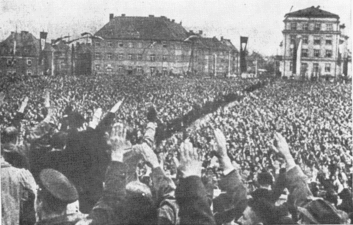 SdP's assembly on 1 May 1938 in Liberec
SdP's assembly on 1 May 1938 in Liberec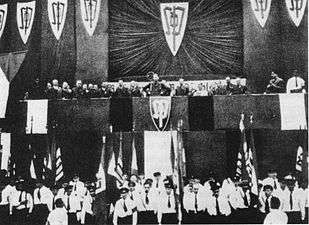 K.H.Frank speaking during 1938 SdP congress
K.H.Frank speaking during 1938 SdP congress Main street in Aš, where SdP's leadership met on 13 September 1938 before fleeing to Germany
Main street in Aš, where SdP's leadership met on 13 September 1938 before fleeing to Germany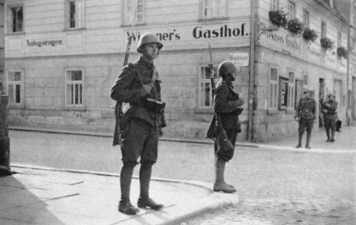 Czechoslovak soldiers patrolling in Česká Lípa
Czechoslovak soldiers patrolling in Česká Lípa
Notable engagements
| Date | Place | Summary | Details |
|---|---|---|---|
| 11 - 14 September 1938 | Cheb | Major unrests by up to 4.000 members of SdP
 |
Cheb, a district town and SdP stronghold, faces major unrests already on 11 September 1938 as SdP tries to disrupt assembly of Czechoslovak automobile association in the town's theater, leading to clashes with police that resulted in 17 lightly wounded policemen and Police Officer Václav Brůžek suffering a severe injury.
On 12 September 1938, immediately after the end of Hitler's Nuremberg speech, mob of up to 4.000 SdP members and supporters rushed into streets, sacking 38 Jewish and Czech shops and lynching Jews and Czechs. Altogether 70 members of Gendarmerie and 30 State Police officers were trying to restore order, using only batons as they were under orders preventing use of firearms apart from necessary self defense. On 13 September the mob in the streets numbered some 2.000 people, but now armed with knives, sticks and stones and also some firearms. The mob tried to push police cordon out of the main square. Several shots were fired in both directions, leading to death of one German while Police Officers Lodr, Anděl and Čmelák suffered injuries in the scuffle. Thereafter mob dispersed. Later during the day reinforcements of 60 policemen and an army unit that included also tanks and infantry fighting vehicles arrived, fully restoring order in the town. On 14 September, police moved to conduct a search warrant of local hotel on suspicion that it was being used to store illegal firearms for Ordners. As police tried to breach the entrance, several perpetrators opened gunfire from hotel windows from rifles, pistols and at least one machinegun. Police Officer Jan Klenner was mortally wounded. Railway worker Emmanuel Bláha that happened to be nearby attempted first to help Klenner, then to return fire with the policeman's rifle, but was also shot dead. Another civilian Václav Tejček tried to help the two but was also shot dead. Immense gunfire from hotel windows hit and killed also three random German civilians in the street. After dusk police used many hand grenades and then entered the building, that was already mostly empty. The only person caught was later released as there was no evidence tying him to the gunfire; according to his testimony a group of around 10 men armed mostly with pistols and with two machineguns was responsible for the shootout.[22] |
| 13 September 1938 | Habartov | Local SdP carries out lawful demonstration in the streets. Armed ordners use mobs to seize post office with telephone switchboard and later also police station, killing four members of Czechoslovak security forces in the process.
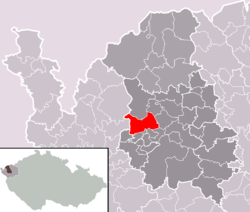 |
In the morning after Hitler's Nuremberg speech local SdP carries out lawful demonstration in the streets after calling for further 300 SdP members from nearby town of Doupov to join. Armed ordners first seize post office with telephone switchboard and take its workers as well as one municipal policemen captive. German mob, many of them armed, surround police station and demand surrender of policemen. Mob forces its way into the building where they corner two and two armed policemen in different rooms. Policemen, under orders not to use firearms, refuse to surrender. Germans try to wrestle firearms from policemen's hands. Failing to do that Germans start shooting, killing Sergeant Major Jan Koukol. Rest of the policemen return fire, killing two attackers and wounding another. Most Germans flee from the station. The three surviving policemen, one of them with hand wounded by gunshot and the two others wounded in face with glass shards, fortify the station while Germans take positions in the houses around the station (which is situated on a ground floor of building that is used also as German-language primary school) start continuous barrage of fire into the station's windows.
Two Orderns are killed and two others seriously wounded during first two hours of shootout, leading Germans to call for more reinforcements against the three policemen whose telephone line was cut. Germans then try to flood the station with use of firefighting vehicle, but are again driven away by police gunfire. Germans then take one of the policemen's wife, put a noose on her neck and send her half-naked in front of the station while holding the other end of the noose, demanding immediate surrender under threat of killing her. Policemen surrender. Constable Matěj Příbek is beaten and locked in nearby house. Constable Jan Paulus is beaten senseless and then two times again after regaining consciousness. Constable Antonín Křepela, after seeing mob attack on Paulus, tries to run away and is shot and wounded. Lying on the ground, Germans beat him to death with clubs and pickaxes. Having lost all contact, county police HQ sends a bus with 15 policemen to Habartov at 1 pm. Immediately after stopping at town square in front of the police station, policemen are subjected to a barrage of fire from Germans hidden in windows in houses overlooking the square. Corporal Stanislav Roubal is shot in the head and killed, Constable Vavřinec Hyka is shot in the head and wounded. Policemen try to get into the station, which is however also occupied by Ordners who open fire as they try to get in. Policemen then scramble towards a house nearby while Sergeant Vladimír Černý is shot in the chest and killed. Eleven policemen manage to get into a house opposite to the station and from which they start firing at the Ordners. At 2 pm, further police reinforcements arrive and Ordners mostly run away towards the border with Germany. Seven perpetrators are caught and arrested, however, due to developments in the following weeks, they escape justice. Court proceedings continue only after WW2, leading to 10 perpetrators receiving the death penalty, six of which are carried out.[23] |
| 13 September 1938 | Stříbrná | SdP attempt to take over police station thwarted.
 |
German mob assembles in front of police station, local SdP leaders demand the immediate surrender of all security forces. Station chief Sergeant Major František Novák makes it clear that police will answer any violence with deadly force, crowd disperses.[24] |
| 13 September 1938 | Bublava | Mob from Germany proper with armed members of SdP take over town, killing three members of Czechoslovak security forces and taking 45 captives to Germany.
 |
In the morning after Hitler's Nuremberg speech, an anti-nazi ethnic German informed Czechoslovak police that a large crowd is gathering in Germany with aim of forcing their way into the town that was lying directly on the border. Around midday, a large crowd from Germany advances towards Czechoslovak customs house, part of which is used for official purposes and part includes flats where customs officers' families live. Meanwhile, Ordners cut the telephone line leading to the customs house. Seven customs officers inside are under strict orders preventing them from shooting in the direction of German border and decide to simply lock doors and wait. SdP members break through the doors and mob floods the customs house. Customs officers decide to surrender their firearms while Germans loot offices as well as private flats. At about 1 pm the crown moves on in the direction of towncenter and police station, which is about 1 km away from the customs house. After a brief standoff, two buses carrying reinforcements with 14 policemen and several soldiers arrive. While the situation around the police station deescalates, one bus is sent with three policemen to the customs house. While trying to negotiate release of customs officials and their family members, policemen are ambushed by Germans shooting from behind concrete barrier on the border. Constable Josef Falber is shot in the stomach and bleeds to death. Constable Bohuslav Kazda is shot in the head close to the ear and loses consciousness. Superintendent Nový returns fire and suffers shot wound into hand and leg. While on the ground, mob attacks him. German customs officers cross border and prevent Nový from being beaten to death. After hearing gunfire, three policemen and four customs officers (whose families are held hostage) drive a second bus towards the customs house. Being ambushed by heavy gunfire, they dismount about 100 meters from the target. Seargant Major Hrádek, police station chief who leads the group, is shot in the leg. Severally outnumbered and with orders preventing them to return fire in the direction of Germany proper, they load wounded Nový and Kazda and drive back to the police station. Ordners send negotiators to the police station. Germans agree to free the customs officers and their wives and children. Family members drive further inland to Czechoslovakia and freed customs officers reinforce police station. Ordners cut the telephone line to the station and start building barricades around the police station. Police chief burns all secret files, shortly thereafter mob breaks through the doors and all 45 members of Czechoslovak security forces surrender with no shots being fired. Altogether 45 captive members of Czechoslovak security forces are taken to Germany proper where they are imprisoned until mid-October when they are returned to Czechoslovak authorities.[25] After successfully dealing with situation in Stříbrná (see elsewhere in this table), Sergeant Major František Novák is ordered to send a patrol to Bublava with which the regional HQ lost telephone contact. Novák himself leads SDG group of two policemen, eight customs officers and two armed civilians. Unknown to them, all members of security forces in Bublava were already captured and kidnapped over the border to Germany. SDG group reaches Bublava after dusk. While advancing towards the police station, the group walks into a well-prepared ambush. An intense firefight erupts. Superintendent Emil Martinů is wounded by the explosion of a hand grenade. Constable Vojtěch Brčák is shot in stomach and dies. Sergeant Major František Novák suffers multiple shot wounds and dies. Armed civilian František Moucha is wounded on head. Customs superintendent Cheníček is wounded in face. Customs officers Hájek, Kovanda and Říšský are also wounded. SDG members scatter, regroup outside of the town and retreat back to Stříbrná. The next day, army unit of about 120 soldiers with three LT-35 light tanks and two armoured fighting vehicles take position on a hill overlooking the town. SdP and Orders cross the border towards Germany proper. Army does not enter the town which remains in no-man's land, seldomly entered both by Czechoslovak and German patrols until the German occupation.[24] |
Freikorps
Formation
Czechoslovakia conducted partial mobilization in May 1938. Many young ethnic-Germans didn't follow the mobilization order and deserted across the border to Germany instead. Thousands more fled as they were receiving mobilization orders after 12 September 1938.[26] Wehrmacht first initiated a plan of including Czechoslovak ethnic-Germans of 20–35 years of age, who had previously undergone military training in the Czechoslovak army, into its own ranks.[27] This was however abandoned as soon as Hitler ordered the establishment of the Sudetendeutsches Freikorps on 17 September 1938.[27] Konrad Henlein was formally named the Freikorp's commanding officer, with Wehrmacht's liaison officer lieutenant colonel Friedrich Köchling, previously serving as liaison officer at Hitler Jugend, being Freikorp's de facto commander.[27] The official purpose of Freikorps, as stated in a telegram to the Oberkommando der Wehrmacht, was the "protection of Sudeten Germans and maintaining further unrest and armed clashes."[28] Wehrmacht was further instructed to conceal its cooperation with Freikorps due to "political reasons".[28]
The Freikorp's ranks were filling up rather fast. It had 10,000-15,000 members by 20 September 1938, 26,000 members by 22 September 1938, with many more deserters coming after the general Czechoslovak mobilization that took place on 23 September 1938[29] and reaching 41.000 by 2 October 1938.[30] Apart from Konrad Henlein, its leadership consisted of K.H.Frank (vice-commander in chief), Hans Blaschek (2nd vice-commander in chief), until-then SdP's senator Anton Pfrogner (chief of staff).[29] Freikorp's headquarters was situated in a castle near Bayreuth, Germany.[29] Freikorp's was divided into 4 groups alongside the whole German-Czechoslovak border. Groups were further divided into battalions and companies. Depending on the border length and local conditions, there were also sometimes "sections" as an interstage between the battalion and companies.[31]
| Group | Reorganized | Staff | Details | Position | Commanding officer |
|---|---|---|---|---|---|
| Group 1 Silesia | Group 5 Lower Silesia Group 6 Wroclaw |
Wroclaw | 11 battalions, 6,851 members (27 September 1938) | From Racibórz to Zittau | |
| Group 2 Sachsen | Group 4 Sachsen |
Dresden | 8 battalions, 7,615 members (27 September 1938) 14 battalions, 13,264 members (1 October 1938) |
From Zittau to Aš | |
| Group 3 Bavaria Ostmark | Bayreuth | 7 battalions, 5,999 members (27 September 1938) | From Aš to Bayerisch Eisenstein | ||
| Group 4 Alps and Danuber | Group 1 Vienna Group 2 Linz |
Vienna | 9 battalions, 7,798 members (29 September 1938) | From Bayerisch Eisenstein to Poysdorf | |
I swear by Almighty God, that as a fighter of the Freikorps, I am aware of my duties and I pledge steadfast allegiance to Adolf Hitler until my death. I swear I shall be brave and loyal fighter of the Freikorps, that I shall be obedient to my superiors and that I shall fulfill all of my duties
— Freikorps Oath[32]
Companies had 150-200 men each and were stationed in German towns and villages along the German-Czech border, each of them being fully equipped for independent cross border raids and assaults.[33] Although the official directive allowed only ethnic-Germans with Czechoslovak citizenship to be part of the Freikorps, due to low number of officers among the deserters their places were filled with members of Nazi Sturmabteilung.[33] SA was further providing training, material support and equipment to Freikorps.[33] All members were getting regular pay for their service.[33] Most members did not have any standardized uniform and were only distinguished by armband with swastika.[34] Formally, they were not part of Wehrmacht and were prohibited from wearing Wehrmacht uniforms.[35]
Members of Freikorps were trained and hosted in Nazi Germany[36] but operated across the border in Czechoslovakia attacking the infrastructure, administrative, police and military buildings and personnel, as well as the pro-government and antifascist ethnic-German civilians, Jews, Jewish owned businesses and ethnic Czech civilians. They committed assassinations, robberies and bombing attacks, retreating over the border to Germany when faced with serious opposition. They murdered more than 110 and abducted to Germany more than 2000 Czechoslovak personnel, political opponents or their family members.[37]
Intelligence service
Freikorps also had its own intelligence service, established on 19 September 1938 with headquarters in Selb, Germany. It was headed by Richard Lammel. The intelligence was gathering information for Freikorps as well as for Abwehr, Sicherheitsdienst (SD) and Gestapo.
Green Cadres
Many ethnic-Germans who deserted after receiving mobilization order didn't go across the border to Germany, but rather established own guerrilla units. Operating from forests in Czechoslovakia, they received name the Green Cadres, sometimes being referred to as Green Freikorps, although they were not officially incorporated as part of German Freikorps.
Armaments
In order to conceal the level of cooperation between Wehrmacht and Freikorps, the original orders stated that Freikorps should be armed only with weapons from warehouses of the former Austrian army.[28] This however led to delays in arming of Freikorps and became outright impossible as regards ammunition and explosives, which were being delivered from Wehrmacht's own supplies.[34] Most common weapons were Mannlicher 1895 8×56 Msch., K98k 8×56 JS, pistols P08 9mm Parabellum, Bergmann machine guns and sub-machine guns and German hand grenades. Due to the initial Czechoslovak orders forbidding use of firearms apart from self-defense, Freikorps also captured Czechoslovak weapons, mostly vz.24 rifles and vz.26 machine guns.
Meanwhile, the Green Cadres, as well as other ordners that did not join Freikorps, were armed with a variety of hunting rifles and shotguns, pistols, as well as many sub-machine guns that had been previously supplied by Germany to the Ordnersgruppe/Freiwilliger Schutzdienst. Scoped hunting rifles in hands of skilled ordners proved especially deadly.
Czechoslovak security forces
Following the Remilitarization of the Rhineland, Czechoslovak authorities came to the conclusion that any future war would most probably take place by a sudden attack without formal declaration of war. At the time, protection of borders was mostly vested into the authority of the Customs Administration (also called Financial Police), which was controlling the border crossings and collecting customs duties, while Gendarme officers were taking care of general law enforcement mainly within towns. This was deemed insufficient as the Customs Administration could merely enforce the custom duties and general order at border crossings, but not security along the whole border.[20] In 1936, the State Defense Guard was established. Normally, SDG would function only in a very limited way necessary to ensure full readiness of its structure (under authority of Ministry of Interior), with its ranks being filled up with personnel in case of emergency (under military command). Its main task was protecting the Czechoslovak border and it was supposed to be able to immediately close and defend the border for the time that would be necessary for the army to reach the attacked areas in full combat readiness. Initially, the State Defense Guard was composed of selected members of Customs Administration, Gendarme and State Police, but later its ranks were filled also with reliable civilians. In case of any unrest, its squads were further boosted by army soldiers. State Defense Guard included also ethnic-Germans that were deemed loyal to Czechoslovak state (mostly Social Democrats and communists). The State Defense Guard has thus become the main target of the Freikorps' activities.
Up to 22 September 1938 the Czechoslovak security forces were under general orders not to use their firearms apart from self-defense.
Republikanische Wehr
Republikanische Wehr was Czechoslovak ethnic-German anti-fascists militia with several thousand members. Known also as Rote Wehr (Red Defense), its members also took part in the fights, supporting the Czechoslovak authorities. Several of its members were killed by the Nazi forces during the clashes, with thousands more being interned in concentration camps following the Munich Agreement and occupation of Czechoslovakia.
Undeclared German–Czechoslovak War
| Undeclared German–Czechoslovak war | |||||||
|---|---|---|---|---|---|---|---|
| Part of German occupation of Czechoslovakia | |||||||
| |||||||
| Belligerents | |||||||
|
| ||||||
| Commanders and leaders | |||||||
|
| ||||||
| Casualties and losses | |||||||
|
Freikorps:
|
Armed forces:
| ||||||
|
Violence led large number of Jews, Czechs and anti-fascist Germans to flee from borderlands further to inland Czechoslovakia. Assaults continued also after Czechoslovakia ceded the borderlands to Germany. Freikorps number according to official Freikorps closing report, real tally probably much higher. | |||||||
The first Freikorps assaults took place already in the night from 17 to 18 September 1938 in the area of Aš. Other major Freikorps assaults included, inter alia:
18 September 1938
| Place | Assailants | Assaulted | Details | Outcome |
|---|---|---|---|---|
| Aš | Unknown number of Freikorps members | Several Customs officers | 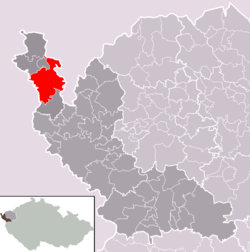 Municipality of Aš |
2 Customs officers seriously wounded |
| Bílá Voda | Unknown number of Freikorps members | Several Gendarme officers, several Customs officers | Jeseník District |
1 Gendarme officer seriously wounded |
19 September 1938
| Place | Assailants | Assaulted | Details | Outcome |
|---|---|---|---|---|
| Český Heršták | Unknown number of Freikorps members | SDG Squad | Český Krumlov District |
1 Customs Officer serious wounded 1 Freikorps member dead |
| Horní Malá Úpa | Customs house
|
Trutnov District |
1 Gendarme officer killed Several officers wounded 2 Czechoslovak state official abducted and interned in a prison in Hirschberg, Germany | |
| Mladkov | 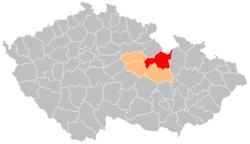 District Ústí nad Orlicí |
|||
| Rychnůvka | 8 members of Freikorps | SDG Motorcycle messenger | Český Krumlov District |
Gendarme Officer Antonín Měsíček killed |
| Starostín | Unknown number of Freikorps members | Several Customs officers | Náchod District |
2 Customs officers seriously wounded |
| Znojmo | Up to 300 Freikorps members | Customs Administration | Znojmo District |
|
| Železná Ruda | 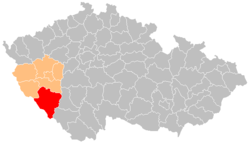 Klatovy District |
|||
20 September 1938
On 20 September 1938, Freikorps headquarters issued Order No. 6 signed by Henlein.[43] According to the order, each of the groups was supposed to undertake at least 10 major raids into Czechoslovak before morning of 21 September.[43] The order further specified that Freikorps shall take no regard to any aversion to the armed assaults that it had previously encountered from some ethnic-German civilians.[44] Moreover, each group was ordered to establish its own intelligence staff that would be providing information to the center in Selb.[44] In line with the order, Freikorps attacks increased both in their frequency as well as brutality.[15]
21 September 1938
| Place | Assailants | Assaulted | Details | Outcome |
|---|---|---|---|---|
| Aš |
|
50 members of Czechoslovak State Police and local police force |  Municipality of Aš Meanwhile, Freikorps took over also local gendarme station after they threatened to set the station ablaze with hand grenades.[45] |
50 policemen abducted and interned in a concentration camp in Germany Police Chief abducted and imprisoned by Gestapo in Nuremberk |
| Bartulovice | Unknown number of Freikorps members | State Defense Guard
|
Bruntál District |
1 Czechoslovak state official abducted and interned in a concentration camp in Germany |
| Habartice | Unknown number of Freikorps members |
State Defense Guard squad (18 members) | Liberec District |
4 SDG members seriously wounded 3 dead, 16 wounded assailants |
| Nové Vilémovice | Unknown number of Freikorps members | 8 Customs officers | Jeseník District |
1 Customs officer killed |
| Petrovice |  Petrovice |
|||
| Wies (Cheb) | 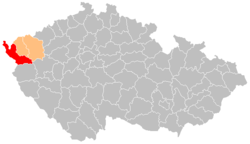 Cheb District |
22 September 1938
On the night of 21 September 1938, German radio broadcast false information that Czechoslovakia agreed to cede its border areas to Germany. Next day, most ethnic-German majority towns were full of German Nazi flags and Hitler's portraits, while Freikorps and ethnic-German mobs unleashed a wave of attacks against state authorities and non-German civilians.[50]
On 22 September, Adolf Hitler gave orders to provide Freikorps also with German weaponry, ammunition and equipment (until that moment, Freikorps were to be armed only with weapons that Germany obtained with Anschluss of Austria).[51]
Czechoslovak forces' order not to use firearms except in self-defense was called off during the day.
By 24 September 1938, Freikorps conducted over 300 raids against Czechoslovak authorities.
| Place | Assailants | Assaulted | Details | Outcome |
|---|---|---|---|---|
| Bartošovice v Orlických horách | Unknown number of Freikorps members | Customs house
|
District Rychnov nad Kněžnou |
Customs house burned to the ground. |
| Bernartice | Unknown number of Freikorps members |
|
Jeseník District |
20 Czechoslovak state officials abducted and interned in a concentration camp in Germany. |
| Bílá Voda | Unknown number of Freikorps members | State Defense Guard squad | Jeseník District |
15 Czechoslovak state officials abducted and interned in a concentration camp in Germany. |
| Cetviny | 150 Freikorps members |
|
Český Krumlov District Czechoslovak forces recaptured the area after heavy fights in the following days. Considering it too vulnerable, it was then left without permanent presence.[55] |
Several Czechoslovak officials wounded and kidnapped to Germany |
| Černá brána ner Varnsdorf | 70 Freikorps Members | SDG Squad | 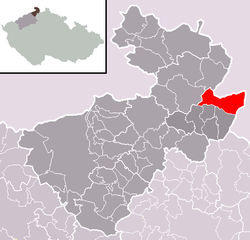 Varnsdorf |
Two wounded soldiers |
| Černá Voda | ethnic-German mob |
|
Jeseník District |
2 Customs officers lynched 2 Freikorps members shot and wounded |
| Dolní Podluží | Děčín District 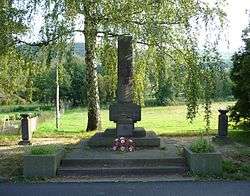 Memorial to Jan Teichman and Josef Kozel |
2 customs officers killed 1 customs officer wounded and kidnapped 1 civilian killed | ||
| Frýdlant |
Unknown number of Freikorps members |
2 infantry fighting vehicles with crews |
Liberec District |
Freikorp's attempt to take over town thwarted by mere army presence. |
| Heřmanice |
Unknown number of Freikorps members |
2 unarmed civilians | Liberec District |
1 civilian murdered, 1 civilian abducted, interned and murdered in a concentration camp in Germany |
| Heřmánkovice | 60 Freikorps members | SDG squad | Náchod District |
Attempt to take town over was thwarted. |
| Hnanice | 200 Freikorps members | Custom House
|
Znojmo District |
1 dead, several wounded SDG members 24 dead, 37 wounded Freikorps members |
| Hrádek nad Nisou | 200 Freikorps members | SDG Station | Liberec District |
two dead, about 50 wounded Freikorps members |
| Javorník | 100+ members of Freikorps | State Defense Guard
|
Jeseník District |
15 Czechoslovak state officials abducted and interned in a concentration camp in Germany. |
| Libná (town doesn't exist today) Zdoňov Horní Adršpach |
Unknown number of Freikorps | SDG | Náchod District |
Several wounded SDG officer wounded and abducted to Germany customs house burned to the ground |
| Liptaň |
|
6 Gendarme officers | Bruntál District Mob leaders compelled Chief Constable Rudolf Mokrý to call to nearby station in Mokrá where gendarme already surrendered. Gaining information that several nearby stations were handed over without any violence with Czechoslovak official mostly being allowed to withdraw inland, still under orders preventing use of firearms and facing armed mob, the station chief agreed to surrender the station. Germans took the officers' firearms and held them captive inside the building while someone was sent to procure a car that could be used to transport the captives (it is unknown whether inland or to Germany). Shortly after the officers within the station building were disarmed, two gendarme officers driving on a motorcycle arrived to town. As they were nearing the station, firefight erupted. In general confusion, Germans started shooting not only at the officers, but also at each other; it is not known whether the officers managed to fire their weapons. The officers used the chaos and attempted to reach the station, not knowing that it was already fully under German control. Both gendarme officers Inocenc Dostál and Vítězslav Hofírek were shot dead immediately after entering the station. Outside of the station, most of the mob dispersed, leaving behind three dead bodies and several angry Freikorps members. The remaining disarmed gendarme officers Chief Constable Rudolf Mokrý, Constable Vilém Leher and Constable Ludvík Svoboda were dragged outside of the station and lynched to death. Constable František Čech, station's messenger, was also lynched to death either with the three other officers or elsewhere in the town's vicinity.[62] Gendarme officers' bodies were transported over the border to German town Lischwitz where they were buried in an unmarked mass grave.[63] Their fate remained unknown until March 1939 German invasion of the remainder of Czechoslovakia, when German authorities acknowledged their deaths. The victims' bodies were later exhumed and ceremonially buried in Czechoslovakia. The culprits were never captured (although having been identified), however, three other Germans that took part in the attack were arrested, tried and executed by hanging in October 1946.[63] |
6 Gendarme officers lynched to death 3 assailants killed |
| Malonty | Several dozen Freikorps members | Several members of Gendarme | Český Krumlov District |
Retreat of local Gendarme |
| Mikulovice | Unknown number of Freikorps members | State Defense Guard squad | Náchod District |
5 Freikorps members arrested. |
| Studánky (Vyšší Brod) | Freikorps | Customs Administration | Český Krumlov District |
Takeover of Customs house[59] |
| Třemešná | Freikorps | Gendarme station (4 officers) | Freikorps takeover of Gendarme station and local post office. Some officers/postal workers are let go inland, some abducted to Germany. Bruntál District |
Takeover of Gendarme station, abduction of several officers to Germany[64] |
| Vápenná - Supíkovice - Rejvíz | Unknown number of Freikorps members | Gendarme | Jeseník District |
1 Gendarme officer killed in action, 6 wounded |
| Varnsdorf | Several hundred Freikorps members | Several dozen SDG members |  Varnsdorf At 10AM a train led by SdP's Czechoslovak Parliament member Franz Werner and full of Freikorps crossed the border. Freikorps took over the train station and captured six soldiers and several railway workers. After some negotiations, SDG squads stationed in the town started retreating inland. One SDG squad leader orders his men to surrender leading to their kidnapping to Germany; the man, who is of partially German ancestry, is later uncovered as long-term German agent. There was an army unit with three tanks stationed in nearby Rumburk, however, they were ordered not to relieve SDG in Varnsdorf. At 5 pm, the army unit also left Rumburk and retreated further inland.[66] Varnsdorf retaken by army the following day (see below) |
Town taken over by Freikorps |
| Vidnava |
Unknown number of Freikorps members |
|
Jeseník District |
2 SDG members lynched to death 2 civilians murdered 15 seriously wounded SDG members several seriously wounded civilians |
| Zlaté Hory |
|
10 Gendarme officers | Jeseník District |
10 Czechoslovak state officials abducted and interned in a concentration camp in Germany. |
23 September 1938
On 23–24 September Poland gave an order to the so-called "battle units" of the "Zaolzie Legion", made up of volunteers from all over Poland, to cross the border to Czechoslovakia and attack Czechoslovak units.[69] This followed official Polish request of 21 September for a direct transfer of the Zaolzie area to its own control.[70] and placing some 60.000 Polish soldiers along the border on 22 September.[69] By this time, however, Czechoslovak border fortifications in the area were already manned and in full combat readiness. Polish charge was repulsed and attacking units retreated to Poland without gaining any ground.[69]
Hitler gave new orders under which captured Czechs were to be considered and treated as prisoners of war. Captives that could prove Slovak or Hungarian nationality were to be regarded as refugees to Germany.[9]
By 11 am, Czechoslovak government officially declared it is unable to exercise Czechoslovak authority in two border districts (Osoblaha and Jindřichov). State officials from these regions were ordered to retreat towards a new line of defense manned by the army.[9]
In other areas Czechoslovak army started offensive actions which lead to recapturing of areas in and around Varnsdorf, from which SDG squads retreated in the previous days.[9]
At 11:30 pm, Czechoslovakia declared full army mobilization as well as full stationing of Czechoslovak border fortifications.[9]
| Place | Assailants | Assaulted | Details | Outcome |
|---|---|---|---|---|
| Srbská | Unknown number of Freikorps members | Customs Administration (5 officers) State Defense Guard (12 members) |
Liberec District |
3 Customs officers murdered 3 SDG servicemen killed in action |
| Varnsdorf Krásná Lípa |
Freikorps | Czechoslovak army
|
 Varnsdorf |
Šluknov Hook recaptured. |
24 September 1938
Freikorps leadership gave out an order that Freikorps fighting units must compel ethnic German mayors of Czechoslovak border towns to send telegraphs to the Führer asking for immediate German intervention. The order specifically mentioned that telegrams must reach Hitler before his planned meeting with Chamberlain, and at the same time they shall be sent in a manner that does not connect them back to Freikorps nor does it raise suspicion of concerted action.[71]
Czechoslovak full army mobilization had a chilling effect on Freikorps membership and led to a lower number of attacks.[71] As the Czechoslovak forces started retaking territory lost in previous days, retreating Freikorps were looting public buildings and "confiscating" money and valuables from bank vaults.[71]
German Army (Wehrmacht) was given sole authority over German border areas with Czechoslovakia. This led to quarrels between Freikorps lower officers and Wehrmacht officers over the actual line of command. Freikorps was ordered to conduct raids over the border only after briefing respective local leader of German border guard.[71]
| Place | Assailants | Assaulted | Details | Outcome |
|---|---|---|---|---|
| Brandov | 8 Freikorps | 2 State policemen |  Brandov Heavy fight over the factory started few days later, see below |
1 policeman killed 2 Freikorps members wounded |
| Bruntál | Unknown number of Freikorps members | State Defense Guard
|
Bruntál District |
6 SDG members seriously wounded 1 dead, 8 wounded Freikorps members confirmed, up to 80 Freikorps casualties unconfirmed |
25 September 1938
| Place | Assailants | Assaulted | Details | Outcome |
|---|---|---|---|---|
| Libá (Aš District) |
|
|
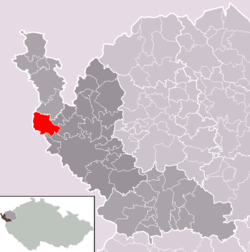 Municipality of Libá within the Aš District Severity of the skirmish led to panic in SdP ranks which requested reinforcements from Germany: SdP reported that they have mere 700 armed men (Freikorps sent from Germany and civilians, mainly members of WW1 veterans association) at their disposal and that they will not be able to hold in case of counterattack. Two SS companies were sent from Germany and replaced Freikorps at the point of contact. The line remained stable with continuous exchanges of rifle and machinegun fire until the evening of 28 September when SDG squad was ordered to retreat. The hamlet was taken over by SS on 29 September[45] The hamlet was severally damaged in the fighting and immediately used by German propaganda as an example of "Czech terror against German civilians".[45] |
Several wounded SDG members Several German casualties |
26 September 1938
Adolf Hitler ordered Freikorps to conduct more assaults. The number of assaults became higher than in previous days, but didn't reach the intensity of 21–22 September.[73]
| Place | Assailants | Assaulted | Details | Outcome |
|---|---|---|---|---|
| Javorník (Jeseník District) |
|
SDG | Jeseník District |
Javorník area under German control. |
27 September 1938
| Place | Assailants | Assaulted | Details | Outcome |
|---|---|---|---|---|
| Brandov | 200 Freikorps | SDG |  Brandov Freikorps recaptured the entire town as well as local small arms factory the next day, only to be pushed back again by SDG on 29 September.[72] |
8 soldiers seriously wounded, 1 captured and beaten to death by Freikorps (private Michal Vimi, 2nd Unit of 1st Battalion of 28th Regiment) 15 dead and 25 wounded Freikorps members |
| Rychnůvka | Unknown number of Freikorps | SDG Squad | Český Krumlov District |
Several wounded SDG members Several wounded or dead Freikorps members |
28 September 1938
| Place | Assailants | Assaulted | Details | Outcome |
|---|---|---|---|---|
| Horní Lomany (now part of Františkovy Lázně) |
Unknown number of Freikorps members | Customs patrol SDG squad |
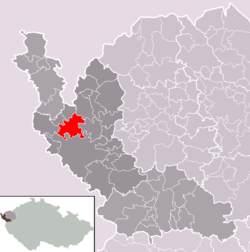 Františkovy Lázně The same day in the evening, Freikorps opened fire from Házlov towards a position of SDG in Horní Lomany. SDG squad carried out assault against the enemy in an infantry fighting vehicle, killing two Freikorps members before retreating back to original position.[74] |
1 Customs officer ambushed and killed 2 Freikorps members killed |
| Lísková | Monument in Dolní Podluží commemorating Josef Röhrich, member of the Czechoslovak Customs Administration, killed by the Germans on 28 September 1938 (Plzeň Region, Czech Republic).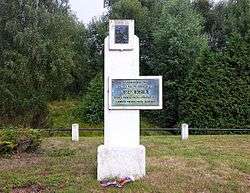 Memorial to Josef Röhrich |
1 Customs officer killed | ||
| Načetín (Kalek) | 60 Freikorps members | 3 SDG members | Chomutov District |
12 Freikorps wounded, 2 dead |
29 September 1938
| Place | Assailants | Assaulted | Details | Outcome |
|---|---|---|---|---|
| Pohraničí (Reizenhain) | Large number of Freikorps | SDG Squad (23 members) | Chomutov District |
Several wounded Freikorps members |
| Načetín (Kalek) | Freikorps | 3 SDG members | Chomutov District |
Freikorps pushed back |
30 September 1938
Following the signing of the Munich Agreement, Freikorps leadership gave orders to cease cross-border assaults.[76] At the same time, Hitler decided that Freikorps shall be subordinate to SS Command, and not to Wehrmacht as were his previous orders. Freikorps were supposed to conduct police powers within the territory of occupied Czechoslovakia.[76]
According to a final report of Friedrich Köchling, officially Wehrmacht's liaison officer to Freikorps but its de facto leader up to 4 October 1938, Freikorps had killed 110 people, wounded 50 and kidnapped 2,029 to Germany. The report lists 164 successful and 75 unsuccessful operations that lead to 52 fatalities, 65 seriously wounded and 19 lost members of Freikorps.[77]
From 7 October 1938, Freikorps was headquartered in a former Czechoslovak Bank building in Cheb. On 10 October 1938 Freikorps was officially disbanded.[78]
As Freikorps operations involved a large scale looting and "borrowing" in its area of operation, aggrieved parties were given up to 15 November 1938 to request damages from newly established German authorities in the occupied area. Court cases dealing with these claims were running as far as 1942.[78]
Criminal liability
Germany
Being aware that Freikorps actions involved a large-scale criminal activity, Adolf Hitler issued a decree on 7 June 1939, according to which all of the actions that were criminal under Czech law shall be considered lawful under German law, and those that were criminal under German law were pardoned.[79]
Czechoslovakia
Majority of Freikorps members were formally Czechoslovak army deserters (especially after the full army mobilization order of 23 September) and their mere membership in Freikorps was punishable by life imprisonment under Czechoslovak act No. 50/1923, on the protection of the Republic. Meanwhile, their active participation in crossborder raids which included murders, attempted murders and kidnapping was punishable by death under the 1852 Criminal Code.[80]
The vast majority of the perpetrators avoided justice through the postwar Expulsion of Germans from Czechoslovakia.[79]
Individual cases were decided by a Special Tribunal set up in the city of Cheb. The Tribunal decided 62 cases, last on 29 October 1948. 10 Freikorps members were sentenced to death (of which 6 were carried out), 16 to life imprisonment, 5 to 30 years imprisonment, 10 to 25 years imprisonment and 16 to 20 years imprisonment. The majority were however released and expelled to Germany already in 1955, which was the year in which Czechoslovakia officially declared the end of the war with Germany that started on 17 September 1938 with first Freikorps crossborder operations.[79]
Brandenburg Division
Based on the successful utilization of Freikorps' tactics against Czechoslovakia and in psychological warfare against Czechoslovak allies, Abwehr later in September 1939 established the so-called "1st Construction Training Company for special purposes" (1. Baulehr-Kompanie Brandeburg z.b.V.) that had former Freikorps members as their core. This later rose to the size of division. The division was known for large scale use of tactics that involved its soldiers wearing enemy uniforms, conducting saboteur actions behind enemy lines and many war crimes.[81]
References
- Munich, 1938: Appeasement and World War II By David Faber page 316 "His chosen method was the establishment of the Sudeten German Freikorps, a terrorist organization which brought together and armed all those Sudeten Germans who had fled Czechoslovakia for Germany"
- The Surreal Reich - p. 144 Joseph Howard Tyson 2010 Political agitator Konrad Henlein, with the collusion of Nazi secret service agencies, engaged in terrorism against Prague's government. Over one hundred of his Freikorps irregulars had been killed in two-hundred-some “commando raids
- Czechoslovakia between Stalin and Hitler - p. 212 Igor Lukes 1996 The party's specialists in low-level warfare, the Sudetendeutsches Freikorps, were among those who eagerly awaited an opportunity to attack. 14 They had been trained in the art of terrorism by Wehrmacht, SS, and SA instructors
- Canaris: The Life and Death of Hitler's Spymaster - p. 134 Michael Mueller 2007 to guarantee the protection of the Sudeten Germans and maintain the unrest and disturbances; terror squads were to be formed from the Freikorps's sub-unit to create constant unrest in the border region
- "Finanční stráž na Jesenicku během sudetoněmeckého povstání v roce 1938", Martin Ivan, Jesenicko v roce 1938, retrieved 13 September 2015
- President Beneš' declaration made on 16 December 1941
- Note of the Czechoslovak government-in-exile dated 22 February 1944
- Constitutional Court of the Czech Republic (1997), Ruling No. II. ÚS 307/97 (in Czech), Brno Stran interpretace "kdy země vede válku", obsažené v čl. I Úmluvy o naturalizaci mezi Československem a Spojenými státy, publikované pod č. 169/1929 Sb. za účelem zjištění, zda je splněna podmínka státního občanství dle restitučních předpisů, Ústavní soud vychází z již v roce 1933 vypracované definice agrese Společnosti národů, která byla převzata do londýnské Úmluvy o agresi (CONVENITION DE DEFINITION DE L'AGRESSION), uzavřené dne 4. 7. 1933 Československem, dle které není třeba válku vyhlašovat (čl. II bod 2) a dle které je třeba za útočníka považovat ten stát, který první poskytne podporu ozbrojeným tlupám, jež se utvoří na jeho území a jež vpadnou na území druhého státu (čl. II bod 5). V souladu s nótou londýnské vlády ze dne 22. 2. 1944, navazující na prohlášení prezidenta republiky ze dne 16. 12. 1941 dle § 64 odst. 1 bod 3 tehdejší Ústavy, a v souladu s citovaným čl. II bod 5 má Ústavní soud za to, že dnem, kdy nastal stav války, a to s Německem, je den 17. 9. 1938, neboť tento den na pokyn Hitlera došlo k utvoření "Sudetoněmeckého svobodného sboru" (Freikorps) z uprchnuvších vůdců Henleinovy strany a několik málo hodin poté už tito vpadli na československé území ozbrojeni německými zbraněmi.
- Hruška, p. 72
- Statistický lexikon obcí v Republice československé I. Země česká. Prague. 1934.
Statistický lexikon obcí v Republice československé II. Země moravskoslezská. Prague. 1935. - Eleanor L. Turk. The History of Germany. Westport, Connecticut, USA: Greenwood Press, 1999. ISBN 9780313302749. Pp. 123.
- Noakes & Pridham 2010, pp. 100–101, Vol. 3.
- Hruška, Emil (2013), Boj o pohraničí: Sudetoněmecký Freikorps v roce 1938 (1st ed.), Prague: Nakladatelství epocha, Pražská vydavatelská společnost, p. 11
- Hruška, Emil (2013), Boj o pohraničí: Sudetoněmecký Freikorps v roce 1938 (1st ed.), Prague: Nakladatelství epocha, Pražská vydavatelská společnost, p. 9
- Hruška, p. 12
- Hruška, p. 13
- Hruška, p. 14
- Hruška, p. 14
- Hruška, p. 15
- Hruška, p. 17
- Hruška, p. 30
- Bružeňák, Ciglbauer, Koc, Kolář, Rejthar, Vaněček, Zatloukalová, pp. 49-57
- Vladimír Bružeňák, Jan Ciglbauer, Karel Koc, Ondřej Kolář, Milan Rejthar, Jiří Vaněček, Alena Zatloukalová (2019), Muži na hranici: Boje se sudetoněmeckými Henleinovci v roce 1938 (1st ed.), Prague: Nakladatelství epocha, Pražská vydavatelská společnost, p. 11CS1 maint: multiple names: authors list (link)
- Bružeňák, Ciglbauer, Koc, Kolář, Rejthar, Vaněček, Zatloukalová, p. 23
- Bružeňák, Ciglbauer, Koc, Kolář, Rejthar, Vaněček, Zatloukalová, p. 17
- Hruška, p. 33
- Hruška, p. 34
- Hruška, p. 35
- Hruška, p. 37
- Hruška, p. 73
- Hruška, p. 38
- Hruška, p. 37
- Hruška, p. 42
- Hruška, p. 43
- Hruška, p. 44
- Lukeš, I (1996) Czechoslovakia between Stalin and Hitler, The Diplomacy of Edvard Beneš in the 1930s, Oxford University Press, P212
- Zimmermann, Volker: Die Sudetendeutschen im NS-Staat. Politik und Stimmung der Bevölkerung im Reichsgau Sudetenland (1938-1945). Essen 1999. (ISBN 3884747703)
- Hruška, pages 44-5.
- Hruška, page 47.
- webmaster@budejckadrbna.cz, TRIMA CB Advertisement. "Horký podzim 1938 v jihočeském pohraničí – 4. část". Budějcká Drbna - zprávy z Českých Budějovic a jižních Čech (in Czech). Retrieved 2018-10-11.
- http://www.ceskenarodnilisty.cz/clanky/Straz.htm
- "Stráž obrany státu při obraně republiky 1938-1939". Retrieved 11 October 2018.
- Hruška, p. 47
- Hruška, p. 48
- Hruška, p. 58-61
- Procházka, pages 78-80.
- "Příhraniční incidenty na Frýdlantsku v září 1938", Jiří Dub, Válka.cz, retrieved 16 October 2004
- Hruška, p. 49
- Procházka, pages 39–41.
- Procházka, pages 44.
- Hruška, p. 68
- Havelka, Ladislav. "Útok na celní úřad v Bartošovicích; 22. září 1938". www.1-prapor-sos.wz.cz (in Czech). Retrieved 2018-10-11.
- Procházka, pages 13.
- Procházka, pages 14.
- "O Cetviny se před válkou bojovalo, pak městečko zaniklo". May 2018.
- Hruška, p. 71
- František VAŠEK, Diverzní a psychologické operace II. oddělení Abwehru v severovýchodních Čechách a severozápadní Moravě 1936 – 1939, část II., s. 56, Historie okupovaného pohraničí 2, Univerzita Jana Evangelisty Purkyně Ústí nad Labem, 1998.
- Hruška, p. 70
- Hruška, p. 70
- Procházka, Petr (2007), Příběhy z pohraničí (1st ed.), Jeseník: Hnutí Brontosaurus Jeseníky, p. 13
- Procházka, Petr (2007), Příběhy z pohraničí (1st ed.), Jeseník: Hnutí Brontosaurus Jeseníky, pp. 17–19
- Bružeňák, Ciglbauer, Koc, Kolář, Rejthar, Vaněček, Zatloukalová, p. 25 - 32
- Procházka, pages 35-38.
- Bružeňák, Ciglbauer, Koc, Kolář, Rejthar, Vaněček, Zatloukalová, p. 33 - 38
- Procházka, pages 20-22.
- Hruška, p. 71
- Procházka, pp. 60–67.
- Procházka, pp. 35-38.
- Erik Goldstein, Igor Lukes (1999), The Munich Crisis, 1938: Prelude to World War II, New York, p. 122, ISBN 9781136328398, retrieved 18 September 2018
- Jesenský, Marcel (2014-09-02), The Slovak–Polish Border, 1918-1947, ISBN 9781137449641, retrieved 18 September 2018
- Hruška, p. 74
- "Odhalení pomníku v Brandově | Obec Mladý Smolivec".
- Hruška, p. 77
- Hruška, p. 64
- Hruška, p. 80
- Hruška, p. 81
- Hruška, p. 95
- Hruška, p. 96
- Hruška, p. 102
- Hruška, p. 101
- Hruška, p. 100